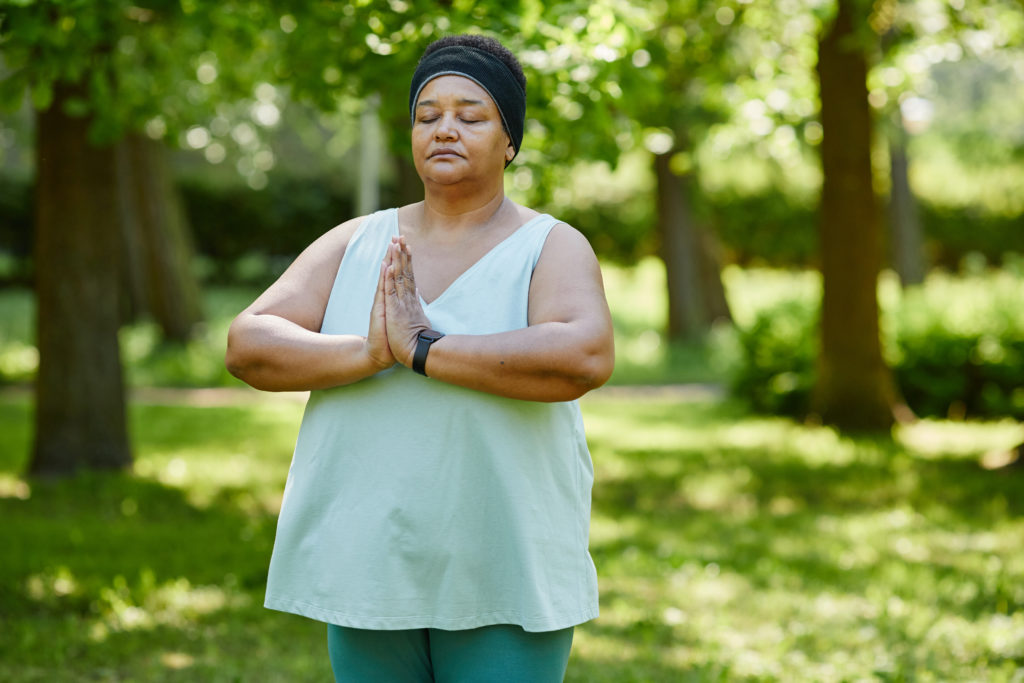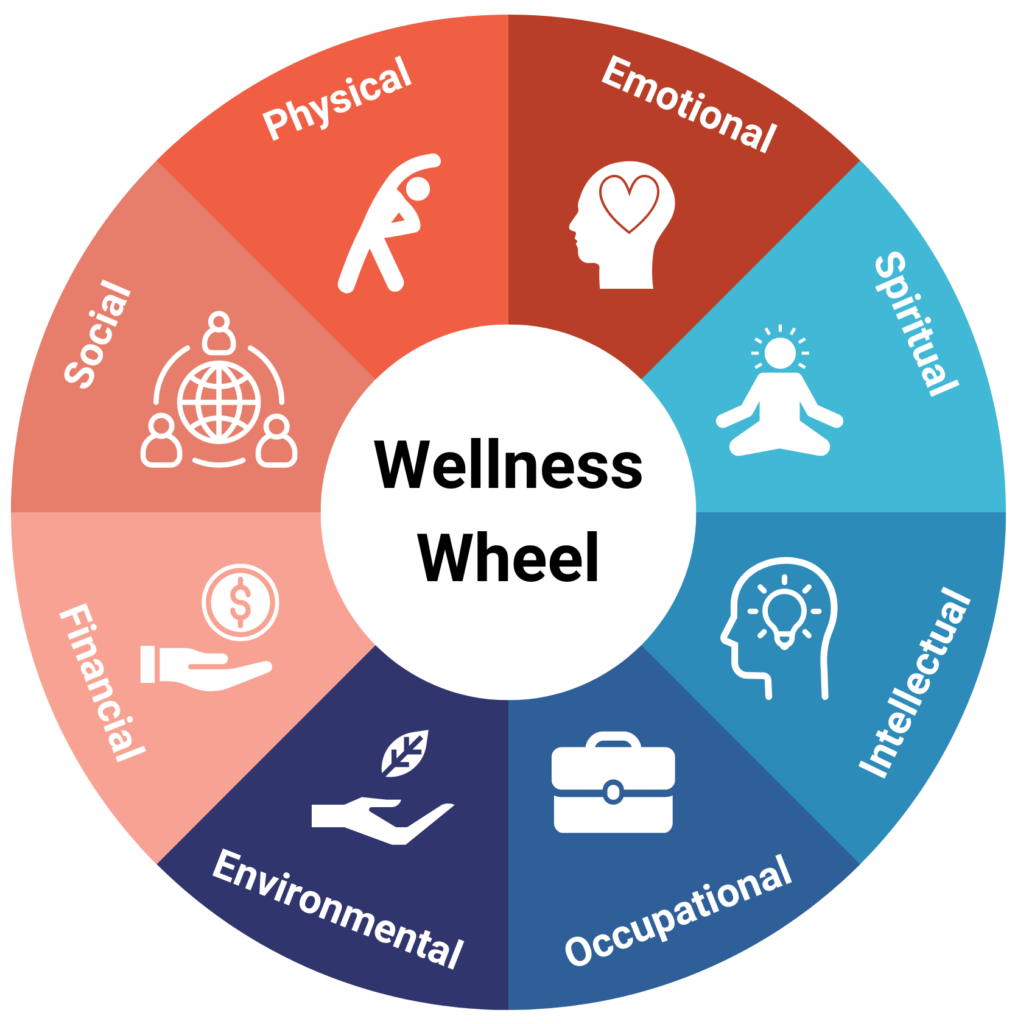When we feel unwell, it is common to focus on treating physical symptoms. For example, if our backs are hurting, we assume there must be something wrong with the muscles and tissues of our low backs. If our stomachs are upset, we begin to think about what we last ate or if we recently interacted with anyone who had been sick.
By viewing pain, discomfort, or disease in this way, we may miss an opportunity to identify the root cause of the problem. Using the examples above, the back could be sore due to muscle tightness or strain. But, what if the cause is actually increased stress, poor sleep positioning, or poor posture? One’s stomach could be upset due to food poisoning or coming into contact with someone who had just been sick. But, what if it is just anxiety about a big project that is due later that day?
When we consider all of the areas of our lives that can impact our health and wellness, we begin to view our health holistically. Holistic health approaches wellness with a wide lens. It recognizes the interconnectedness of the mind and the body. It considers how our emotional, social, environmental, intellectual, and financial well-being contribute to our overall wellness.
By viewing health with a holistic lens, we are better able to identify the root causes of discomfort or disease. This sets us up for greater success in caring for, treating, and preventing them in the future. Read on to learn more about holistic health and how a tool called “The Wellness Wheel” can help you assess your holistic wellness.
What is Holistic Health?
As mentioned above, holistic health is an approach to well-being that focuses on all areas of wellness.1 This approach to health has been utilized in many alternative medicinal practices and Eastern medicine for centuries. In conventional, Western medicine practices, a holistic lens had been lacking. But, in recent years, there has been a surge of individuals seeking holistic care.

The word holistic stems from the word holism. Holism is derived from the Greek word “holo” which means “whole.” So, holistic health is viewing the whole person, not just a part of them, when considering what makes them well or unwell. In doing so, we highlight the interconnectedness of the human body and the human experience. We also highlight the uniqueness of each individual body and the experiences that individual has in life.
There are multiple areas of our lives to consider when viewing health holistically. Below is a breakdown of these different dimensions of health and wellness.
Physical
Our physical health is the part of our well-being that tends to get the most attention. It is easy to see how well or unwell our physical bodies are just by looking at them. We can see signs and symptoms of various illnesses or diseases. And, these signs and symptoms can be easily tracked through visible changes in the body. In this way, body awareness, or lack thereof, can mirror our physical health. Our physical health also includes our habits related to diet, exercise, and sleep. The medical history of our physical bodies, both past and present, would also influence our physical health.
Emotional
Emotional health is an area of wellness that we too often push to the side or ignore. In many ways, our emotional health is just as important as our physical health. The health of our minds has a direct impact on the health of our bodies. If our emotional landscapes are filled with stress, fear, or anger, our body will start to show it. For example, stress can show up in the body as a quickening heart rate, chest tightness, and increased blood pressure.2 Mental stress can also heighten our perception of pain. So, if we are experiencing pain physically, it will likely be much louder during times of emotional stress.
Apart from its influence on other areas of our health, emotional well-being also includes how we notice and respond to emotions that arise. With practice, we can sense when our emotional health is in balance and when it is out of balance. This awareness helps us to identify which people, places, or things make it better or worse. Developing emotional awareness, mindfulness, and resiliency helps us develop and promote emotional balance and health.

Spiritual
Spiritual wellness is a dimension of our well-being that is often misunderstood. Many associate spiritual wellness and spirituality with religion. Although partaking in religious practices can contribute to an individual’s spiritual wellness, they aren’t required. Spiritual wellness is simply having personal values and beliefs and acting in alignment with those values and beliefs.
Our spiritual wellness is also subject to the influence of the other dimensions of our well-being. It is likely our values and beliefs will change throughout our lifetimes. They will be influenced by the environment we are in, the social connections we have, and the things we learn. They may change after a significant health concern or a period of emotional turmoil. Connecting to our inner and outer worlds will help us stay aware of our values and beliefs. It will also help us stay aware of and live in our purpose.
Intellectual
Our intellectual wellness is expanded through learning something new and utilizing what we already know. Anything that stimulates the brain will contribute, in some way, to our intellectual wellness. Critical thinking, problem-solving, and exposing ourselves to new environments or people are all opportunities to promote intellectual wellness. There is an emphasis on staying curious while recognizing and utilizing the creative abilities we already have. Intellectual wellness isn’t just about mental stimulation, though. There is an emphasis on balancing mental agility with adequate mental rest.
Occupational
Occupational wellness is the enjoyment and satisfaction we get out of a job or occupation. The more our occupations support our goals, personal growth and successes, and aspirations, the healthier our occupational wellness. If you feel overworked and underpaid in your current position, your occupational health could likely use a boost. Similarly, if you are running the risk of burnout, your occupational wellness is more than likely at an all-time low.
Occupational wellness is not just about the satisfaction we find in a job. It is equally important to consider work-life balance. Setting and maintaining boundaries between work and life are key to protecting one’s occupational health. In fact, studies have shown workplace performance increases when proper work-life boundaries are in place.3 So, a healthy work environment will promote balance between job-related tasks and leisure.

Environmental
The space we occupy is key to environmental wellness. We can enhance our environmental wellness by existing in spaces that are pleasant, safe, and accessible. By becoming more aware of the environment around us, we can better identify environments that promote or block our well-being. For example, let’s say you want to start eating healthier. You are motivated, and you have set goals regarding dietary changes. But, you notice that it is challenging to make changes because you are surrounded by unhealthy foods. Every time you make a healthy choice your eyes wander to the unhealthy choices you are trying so hard to eliminate from your diet. Now, imagine that your environment was rid of all of the unhealthy, and potentially tempting foods. It would probably be a bit easier to achieve your goal, right?
Our environment has a big impact on us, and we have a big impact on it. This highlights another component of environmental wellness. This component is the environment and the world around us. It is important to learn about the health of our planet and how you are contributing to it. By doing so, you can better optimize your environmental well-being.
Financial
What is your relationship to money? Assessing your financial wellness is going to prompt you to answer that question. Financial wellness is how we relate to and manage our finances. It also considers whether or not we have the monetary means to provide for ourselves and/or our families in basic ways. Having a desire for more financial freedom would suggest some improvements need to be made to one’s financial wellness. Having an abundance of financial means but mismanaging or spending it carelessly would also signal some improvement is needed in one’s financial wellness.
Sometimes our financial wellness can hinder other areas of our well-being in ways we can’t control. It is important to identify and acknowledge these blocks as we consider our holistic health. By doing so, we can better see what other pieces of the puzzle may be moved to improve our wellness.

Social
The relationships we have and how we interact with others is social wellness. It is our ability to build, share in, and maintain positive connections with those around us. Having a strong sense of social connection offers the support and nurturance we need on a day-to-day basis. It also signifies that we will have support when life throws a challenge our way. It can be helpful to identify what type of friend you are and what you are looking for in connections with others. By knowing what fills up your cup and what drains it in social settings, you will be better equipped to protect your social wellness.
What is a Wellness Wheel?
So, there are a lot of things to consider when assessing our holistic wellness. And, trying to tap into all of these areas of well-being mentally can feel challenging and overwhelming. To better assess the full picture, using a tool or image can be helpful. Let’s dive a bit deeper into what a Wellness Wheel is and how it can be used.
A Wellness Wheel is a tool that we can use to visualize the various components of our well-being. As you can see in the image below, it is a circle divided into eight parts. Each part corresponds with one of the components of wellness that we just discussed above. This tool can be used to visualize each area of our well-being. It can help us notice which areas are well and which areas could use some improvement. It also can serve as a powerful springboard for goal planning and setting.
Try the activity below to assess your holistic health using a Wellness Wheel:

Wellness Wheel Activity
- Begin by finding something to write with and something to write on.
- Then, draw a circle and divide it into eight slices just like the image of the Wellness Wheel above. Make sure to label each section with the dimension of wellness it corresponds to.
- Next, we will use coloring or shading to indicate how well a particular dimension is. For example, let’s begin with physical wellness. If you have a good movement routine, maintain a healthy diet, and don’t have many medical concerns, your physical well-being is probably pretty well cared for. You will then color or shade in the entire wedge. So, the more coloring or shading the healthier. The less coloring or shading, the less healthy.
- Work your way around the entire wheel, coloring or shading in each individual wellness wedge.
- Once you are complete, take a few minutes to take it all in. What stands out to you the most? What surprises you? What areas could use some improvement? What areas are doing well?
- Our holistic health is at its best when all areas of our well-being are balanced. If we think of the Wellness Wheel we have just created as an actual wheel, how smooth of a ride would it provide? If the ride would be kind of bumpy, take some time to consider what things you could do to bring your wellness into balance.
- If you are feeling inspired by your Wellness Wheel to make a change, take some time to set one or two goals to improve your well-being.
- Return to this activity and repeat it in a month. This will allow you to see what, if anything, has changed. It can also clarify what new areas of your well-being need your attention the most.
The Path to Holistic Health

Holistic health is the key to optimizing our wellness. By viewing health in this way, we can nurture every aspect of our lives. This can create balance and help us achieve our highest level of well-being. The Wellness Wheel can be a powerful tool in visualizing and assessing our wellness. It reminds us to consider our physical, emotional, spiritual, intellectual, occupational, environmental, financial, and social well-being equally. By using the results of a Wellness Wheel activity to make changes in our lives, we take steps to becoming the best versions of ourselves. Wellness is a lifelong journey, but it’s never too late to start on the path to holistic health.
References
- Gordon J. S. (1982). Holistic medicine: advances and shortcomings. The Western journal of medicine, 136(6), 546–551.
- Engert, V., Linz, R., & Grant, J. A. (2019). Embodied stress: The physiological resonance of psychosocial stress. Psychoneuroendocrinology, 105, 138–146. https://doi.org/10.1016/j.psyneuen.2018.12.221
- Wong, K., Chan, A. H. S., & Teh, P. L. (2020). How Is Work-Life Balance Arrangement Associated with Organisational Performance? A Meta-Analysis. International journal of environmental research and public health, 17(12), 4446. https://doi.org/10.3390/ijerph17124446
